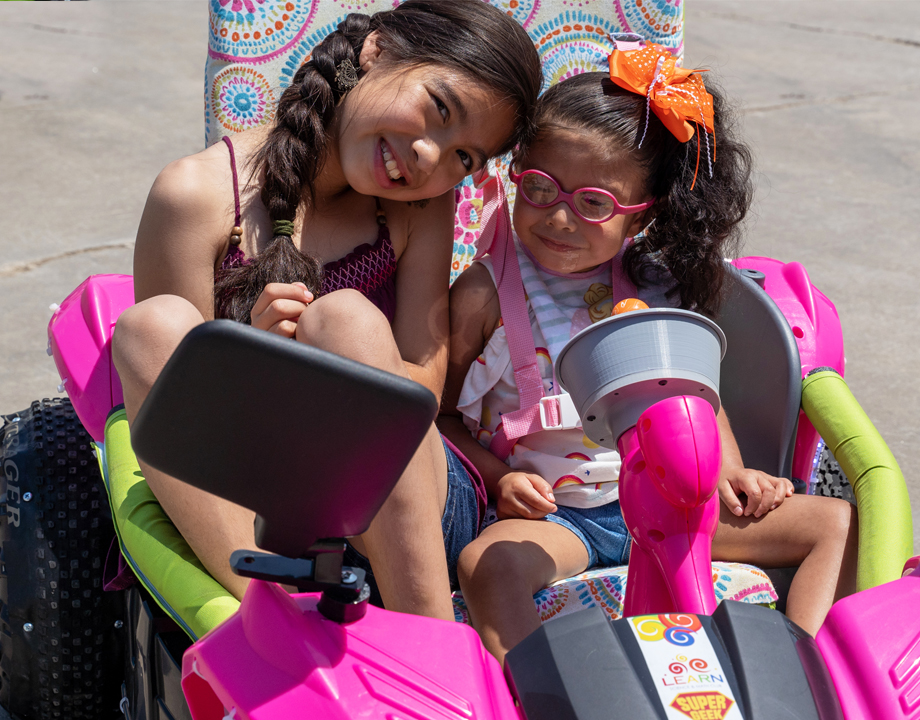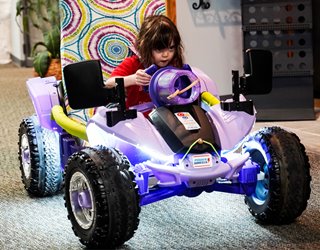Geeks for Kids Gives Power to Play
Geeks for Kids Gives Power to Play


A Kansas City-based nonprofit is aiming to change the way kids with movement limitations experience their world. Photo: Geeks for Kids
Five-year old Maryellen was born with most of her joints dislocated, so it is hard for her to keep up with her friends. A traumatic brain injury slowed two-year-old Jensen’s development, so his mobility is limited. Milo, who is 21 months old, has Spina Bifida and can’t do anything independently when the family goes outside to play.
These are three of more than 500,000 American kids under the age of five who have mobility problems, and few have access to devices that give them free movement. Those who cannot move about as other kids cannot discover their world on their own, and this costs them socially, intellectually, and physically. Having the power to explore the world on their own could dramatically change their lives.
An initiative of LEARN, a Kansas City-based nonprofit, Geeks for Kids is striving to provide that power by changing the way kids with movement limitations experience their world. The volunteers, many of them engineers, are building custom cars for kids who can’t otherwise get around on their own.
“We give them a chance to move about and explore freely–not experience life as passive observers from strollers and wheelchairs,” said Rebecca Kidwell, president of LEARN Science and Math Club. “Plus, we want to make these kids feel ‘cool’ with a hot rod that excites and engages their peers and encourages them to play together.”
Editor’s Pick: Frugal Engineering Goes Beyond Cost
The LEARN Club had been participating in STEM competitions for many years. In 2014, the team submitted a biomedical engineering device for the MIT InvenTeam competition and won a grant to take it from concept to reality. That led the team to think what they could build that would have that same impact on an ongoing basis.
They came across a program at the University of Delaware in which a neurophysicist and the engineering department jointly built little cars for kids with mobility issues, published their work, and invited people around the world to pick up their inspiration. Geeks for Kids was born out of that inspiration.
In the spring of 2017, LEARN’s high school robotics team built first such car and this year they released their 96th car.
Most of the cars thus far have been built on existing toy car products. The first three years were spent on developing a portfolio of adaptations and improving them.
“We have focused on three primary branches of adaptations in these three years. So, drive systems, comfort systems, and ancillary support systems are the three categories that we focused on. We have a design period in the summer, where we work on those and then we perfect and build them over the school year,” Kidwell said, adding that the most challenging of these is the go-button drive.
“It’s like your car steering system but we have disabled the foot pedal and moved the on-off switch under their dominant thumb. So, if a child has a fair amount of upper body strength and fine motor control, this is a great option for them. But if they are not so strong and still have some fine motor control, then we can build them a joystick drive. For these kids who have never had any independent movement, it is so revolutionary and exciting,” Kidwell explained.
You May Also Like: Danielle Boyer’s STEAM Dream
Geeks for Kids holds build events for the cars every year. In March 2020 when COVID-19 hit, work slowed to a crawl with team leaders designing, 3D printing, and putting together sub-assemblies at home. “It shrunk our big builds from 100 builders per session to just 20,” recalled Kidwell.
However, the team refused to let the pandemic stop them. “When we returned to our workshop last May, we promised to deliver cars to every child who applied no matter what. Over the course of the last 18 months, we have built 66 cars that gave 68 kids the power to play," she said.
The work has made an impact far beyond the children served. “We have had many student engineers come through the program in the last three years,” Kidwell said. “Building something for someone else both makes it more real and more important than anything they usually have done.”
Chitra Sethi is executive editor, media.
These are three of more than 500,000 American kids under the age of five who have mobility problems, and few have access to devices that give them free movement. Those who cannot move about as other kids cannot discover their world on their own, and this costs them socially, intellectually, and physically. Having the power to explore the world on their own could dramatically change their lives.
An initiative of LEARN, a Kansas City-based nonprofit, Geeks for Kids is striving to provide that power by changing the way kids with movement limitations experience their world. The volunteers, many of them engineers, are building custom cars for kids who can’t otherwise get around on their own.
“We give them a chance to move about and explore freely–not experience life as passive observers from strollers and wheelchairs,” said Rebecca Kidwell, president of LEARN Science and Math Club. “Plus, we want to make these kids feel ‘cool’ with a hot rod that excites and engages their peers and encourages them to play together.”
Editor’s Pick: Frugal Engineering Goes Beyond Cost
The LEARN Club had been participating in STEM competitions for many years. In 2014, the team submitted a biomedical engineering device for the MIT InvenTeam competition and won a grant to take it from concept to reality. That led the team to think what they could build that would have that same impact on an ongoing basis.
They came across a program at the University of Delaware in which a neurophysicist and the engineering department jointly built little cars for kids with mobility issues, published their work, and invited people around the world to pick up their inspiration. Geeks for Kids was born out of that inspiration.
In the spring of 2017, LEARN’s high school robotics team built first such car and this year they released their 96th car.
Most of the cars thus far have been built on existing toy car products. The first three years were spent on developing a portfolio of adaptations and improving them.
“We have focused on three primary branches of adaptations in these three years. So, drive systems, comfort systems, and ancillary support systems are the three categories that we focused on. We have a design period in the summer, where we work on those and then we perfect and build them over the school year,” Kidwell said, adding that the most challenging of these is the go-button drive.
“It’s like your car steering system but we have disabled the foot pedal and moved the on-off switch under their dominant thumb. So, if a child has a fair amount of upper body strength and fine motor control, this is a great option for them. But if they are not so strong and still have some fine motor control, then we can build them a joystick drive. For these kids who have never had any independent movement, it is so revolutionary and exciting,” Kidwell explained.
You May Also Like: Danielle Boyer’s STEAM Dream
Geeks for Kids holds build events for the cars every year. In March 2020 when COVID-19 hit, work slowed to a crawl with team leaders designing, 3D printing, and putting together sub-assemblies at home. “It shrunk our big builds from 100 builders per session to just 20,” recalled Kidwell.
However, the team refused to let the pandemic stop them. “When we returned to our workshop last May, we promised to deliver cars to every child who applied no matter what. Over the course of the last 18 months, we have built 66 cars that gave 68 kids the power to play," she said.
The work has made an impact far beyond the children served. “We have had many student engineers come through the program in the last three years,” Kidwell said. “Building something for someone else both makes it more real and more important than anything they usually have done.”
Chitra Sethi is executive editor, media.







